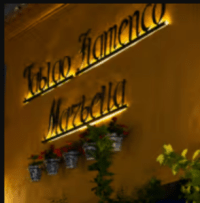Antonio Canales
Antonio Gomez de los Reyes was born into a family of flamenco performers in Seville in 1961. (His grandfather “Canales” was a respected flamenco singer, although not professional). He was born in the heart of Triana, surrounded by the magical flamenco atmosphere that this old area of Seville once had.
He is one of the new breed of modern flamenco dancers that have created their own style of dance, a style that is far removed from the traditional styles from whence their art has developed.
Without scripts or structured compositions, the Flamenco artists let themselves be carried away by improvisation and the passion of flamenco. Witness dancing and singing, where the a cappella voice, the guitar chords and the rhythm of the dancers will fill the stage. Dining optional. Tickets for Flamenco Show at Tablao Flamenco in Marbella.
This cuchichi, or half gypsy, is quite capable of performing the orthodox styles of this art, but like many of today’s younger dancers, his dance is choreographed and mixed with many classical dance styles from outside of the flamenco boundaries.
In his teens he joined the National Ballet of Spain where he would perform alongside other young, modern dancers such as Joaquín Cortés, another of today’s new breed of bailaores. He soon progressed to become one of the National Ballets solo dancers as well as working as guest artiste with many other known flamenco troupes.
In 1981 he danced in Paris with Maguy Marin, (the French dancer and choreographer) which opened the door for Antonio, who went on to perform with other renowned dance figures like Rudolf Nureyev and Vladimir Vasilev.
It was Nureyev who changed people’s expectations towards, as well as the face of, modern ballet, earning him the title of the “Greatest male ballet dancer of the 20th century”. Vladimir Vasilev was the only dancer to ever receive the title of “World’s best dancer” by the Paris Dance Company.
Antonio’s association with these classic ballet dancers showed his capabilities and determination to succeed in the world of dance and he was also honored with many awards for his dedication including the Mauisera Award for best dancer, in Italy in 1988, and in 1990 in Mexico City, he received the award for the Mejor Bailarin Internacíonal.
He formed his own dance company, Ballet Flamenco de Antonio Canales, which debuted with the show A ti Carmen Amaya, a tribute to the dancing queen from Barcelona. This success was followed by a stream of his own productions including Siempre Flamenco, Torero, and an adaptation of Federico García Lorca`s Casa de Bernarda Alba.
Antonio Canales, despite his impromptu attacks on fellow dancers, is respected on the flamenco scene of Seville (as well as the rest of Spain) and he has worked with numerous artistes from Joaquín Cortés and Manuela Vargas to Rocío Jurado; with whom he danced during her farewell concert just months before she died.
Canales also spent a period working with the flamenco fusion group Ketama as well as dedicating much time to his second passion, that of the silver screen. In 1990 he was nominated for an Oscar for his performance in the film Montoya y Tarantos, a film based on the 1963 classic Historia de los Tarantos that included Antonio Gades and Carmen Amaya.
In 1992 Antonio and his flamenco troupe were invited to perform at the “Giants of the Dance” extravaganza, which was held in Paris, and later the same year he performed in New York during the 5th centenary celebrations of the discovery of the new world.
Antonio Canales has traveled the world, exciting audiences everywhere with his classic style of flamenco ballet, and in 1999 he was awarded the Medalla de Andalucía, an honor he was given in recognition for his efforts in promoting his fatherland and his art, world wide.
Antonio Canales is one dancer who uses flamenco as a base for his own personal style of dance. He has that special quality that has become synonymous with the Seville school, (especially with the farruca) and like Cristina Hoyos or even Antonio Gades, he is one of the pioneers who have brought a modern style of flamenco to the very forefront of stages around the world.
Tony Bryant is author of Flamenco An Englishman’s Passion and Flamenco a Tale of Three Cities
Book your stay in Andalucia Now!
